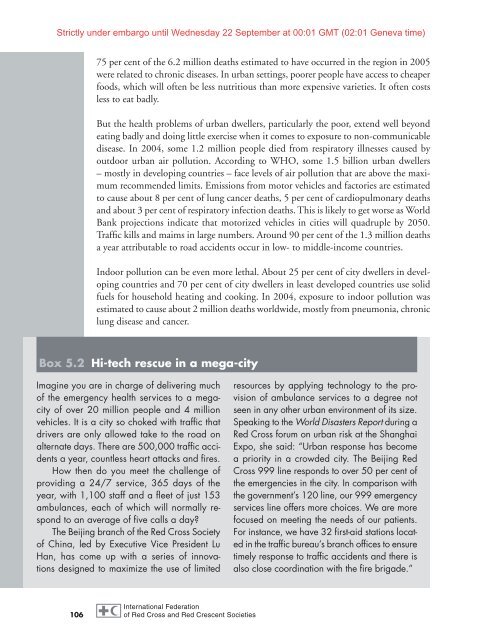chapter 4 - DRK
chapter 4 - DRK
chapter 4 - DRK
Create successful ePaper yourself
Turn your PDF publications into a flip-book with our unique Google optimized e-Paper software.
Strictly under embargo until Wednesday 22 September at 00:01 GMT (02:01 Geneva time)75 per cent of the 6.2 million deaths estimated to have occurred in the region in 2005were related to chronic diseases. In urban settings, poorer people have access to cheaperfoods, which will often be less nutritious than more expensive varieties. It often costsless to eat badly.But the health problems of urban dwellers, particularly the poor, extend well beyondeating badly and doing little exercise when it comes to exposure to non-communicabledisease. In 2004, some 1.2 million people died from respiratory illnesses caused byoutdoor urban air pollution. According to WHO, some 1.5 billion urban dwellers– mostly in developing countries – face levels of air pollution that are above the maximumrecommended limits. Emissions from motor vehicles and factories are estimatedto cause about 8 per cent of lung cancer deaths, 5 per cent of cardiopulmonary deathsand about 3 per cent of respiratory infection deaths. This is likely to get worse as WorldBank projections indicate that motorized vehicles in cities will quadruple by 2050.Traffic kills and maims in large numbers. Around 90 per cent of the 1.3 million deathsa year attributable to road accidents occur in low- to middle-income countries.Indoor pollution can be even more lethal. About 25 per cent of city dwellers in developingcountries and 70 per cent of city dwellers in least developed countries use solidfuels for household heating and cooking. In 2004, exposure to indoor pollution wasestimated to cause about 2 million deaths worldwide, mostly from pneumonia, chroniclung disease and cancer.Box 5.2 Hi-tech rescue in a mega-cityImagine you are in charge of delivering muchof the emergency health services to a megacityof over 20 million people and 4 millionvehicles. It is a city so choked with traffic thatdrivers are only allowed take to the road onalternate days. There are 500,000 traffic accidentsa year, countless heart attacks and fires.How then do you meet the challenge ofproviding a 24/7 service, 365 days of theyear, with 1,100 staff and a fleet of just 153ambulances, each of which will normally respondto an average of five calls a day?The Beijing branch of the Red Cross Societyof China, led by Executive Vice President LuHan, has come up with a series of innovationsdesigned to maximize the use of limitedresources by applying technology to the provisionof ambulance services to a degree notseen in any other urban environment of its size.Speaking to the World Disasters Report during aRed Cross forum on urban risk at the ShanghaiExpo, she said: “Urban response has becomea priority in a crowded city. The Beijing RedCross 999 line responds to over 50 per cent ofthe emergencies in the city. In comparison withthe government’s 120 line, our 999 emergencyservices line offers more choices. We are morefocused on meeting the needs of our patients.For instance, we have 32 first-aid stations locatedin the traffic bureau’s branch offices to ensuretimely response to traffic accidents and there isalso close coordination with the fire brigade.”106
















